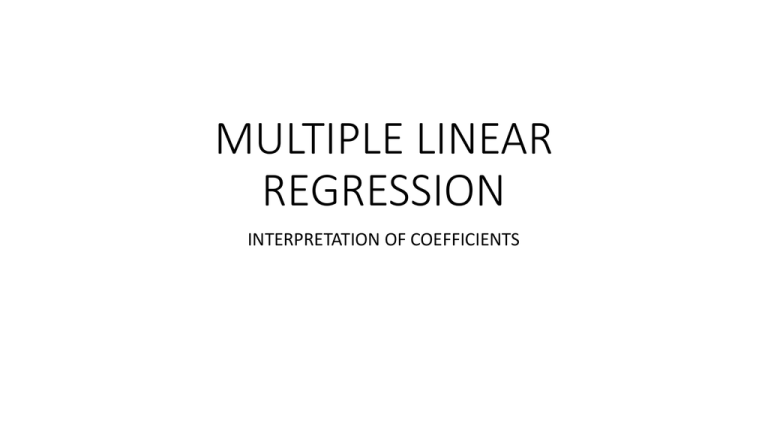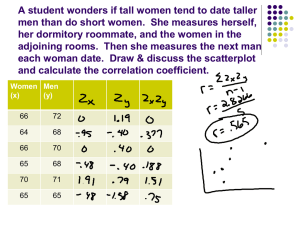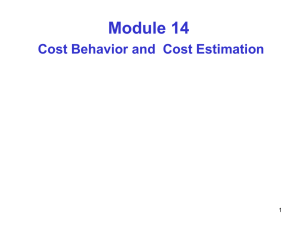
MULTIPLE LINEAR
REGRESSION
INTERPRETATION OF COEFFICIENTS
The Multiple Regression Model
• Regression model for k independent variables:
Yi a b1 X1i b2 X 2i bk X ki ei
• Multiple Regression allows us to:
Use several variables at once to explain the variation in a continuous dependent
variable.
Isolate the unique effect of one variable on the continuous dependent variable while
taking into consideration that other variables are affecting it too.
Write a mathematical equation that tells us the overall effects of several variables
together and the unique effects of each on a continuous dependent variable.
Control for other variables to demonstrate whether bivariate relationships are
spurious
EXAMPLE
For example:
Research Hypothesis: As education of respondents increases, the number of
children in families will decline (negative relationship).
Research Hypothesis: As family income of respondents increases, the
number of children in families will decline (negative relationship).
Independent Variables
Dependent Variable
Education
Number of Children
Family Income
EXAMPLE (contd.)
Y = 11.8 - .36X1 - .40X2
Expected # of Children = 11.8 - .36*Educ - .40*Income
• If graphed, holding one variable constant produces a two-dimensional
graph for the other variable.
Y
Y 11.40
11.44
b = -.4
b = -.36
5.44
6.00
0
15
X1 = Education
0
X2 = Income
15
CONFOUNDING EFFECT
• An interesting effect of controlling for other variables is “Simpson’s
Paradox.”
• The direction of relationship between two variables can change when
you control for another variable.
Education
+
Crime Rate
+
Urbanization
(is related to
both)
Y = -51.3 + 1.5X
Education
+
Crime Rate
Regression Controlling for Urbanization
-
Education
Urbanization
+
Crime Rate
Y = 58.9 - .6X1 + .7X2
Original
Regression Line
Rural
Small town
Suburban
Education
City
Now… More Variables!
• The social world is very complex.
• What happens when you have even more variables?
• For example:
A researcher may be interested in the effects of Education, Income, Sex, and Gender
Attitudes on Number of Children in a family.
Independent Variables
Dependent Variable
Education
Family Income
Number of Children
Sex
Gender Attitudes
• The shape is no longer a line, but if you hold all other variables constant, it is linear for
each independent variable.
• Each variable, holding the other variables constant, has a linear, two-dimensional graph of
its relationship with the dependent variable.
The BLUE Regression Criteria
• Regression forces a best-fitting model onto data. If the model is
appropriate for the data, regression should be used.
• Criteria for determining whether a regression model is appropriate for
the data are nicknamed “BLUE” for best linear unbiased estimate.
• Violating the BLUE assumptions may result in biased estimates or
incorrect significance tests. (However, OLS is robust to most
violations.)
BLUE CRITERIA
1.The relationship between the dependent variable and its predictors is linear
2.No irrelevant variables are either omitted from or included in the equation.
3.All variables are measured without error.
4.The error term (ei) for a single regression equation has the following
properties:
Error is normally distributed
The mean of the errors is zero
The errors are independently distributed with constant variances
(homoscedasticity)
Each predictor is uncorrelated with the equation’s error term*
DUMMY VARIABLES
• They are simply dichotomous variables that are entered into
regression. They have 0 – 1 coding where 0 = absence of something
and 1 = presence of something. E.g., Female (0=M; 1=F) or Southern
(0=Non-Southern; 1=Southern).
• Dummy Variables are especially nice because they allow us to use
nominal variables in regression.
• A nominal variable has no rank or order, rendering the numerical
coding scheme useless for regression.
DUMMY VARIABLES
• The way you use nominal variables in regression is by converting them to a
series of dummy variables.
Nominal Variable
Race
1 = White
2 = Black
3 = Other
Recode into different
Dummy Variables
1. White
0 = Not White; 1 = White
2. Black
0 = Not Black; 1 = Black
3. Other
0 = Not Other; 1 = Other
DUMMY VARIABLES
• When you need to use a nominal variable in regression (like race), just
convert it to a series of dummy variables.
• When you enter the variables into your model, you MUST LEAVE OUT
ONE OF THE DUMMIES.
Leave Out One
White
Enter Rest into Regression
Black
Other
• The reason you MUST LEAVE OUT ONE OF THE DUMMIES is that
regression is mathematically impossible without an excluded group.
DUMMY VARIABLES
• The regression equations for dummies will look the same.
For Race, with 3 dummies, predicting self-esteem:
Y = a + b1X1 + b2X2
a = the y-intercept,
which in this case is
the predicted value
of self-esteem for
the excluded group,
white.
b1 = the slope
for variable
X1, black
b2 = the slope
for variable
X2, other
DUMMY VARIABLES
• If our equation were:
For Race, with 3 dummies, predicting self-esteem:
Plugging in values for the
dummies tells you each
group’s self-esteem average:
Y = 28 + 5X1 – 2X2
White = 28
a = the y-intercept,
which in this case is
the predicted value
of self-esteem for
the excluded group,
white.
5 = the slope
for variable
X1, black
-2 = the slope
for variable
X2, other
Black = 33
Other = 26
When cases’ values for X1 = 0 and X2 = 0, they are white;
when X1 = 1 and X2 = 0, they are black;
when X1 = 0 and X2 = 1, they are other.
DUMMY VARIABLES
• Dummy variables can be entered into multiple regression along
with other dichotomous and continuous variables.
• For example, you could regress self-esteem on sex, race, and
education:
Y = a + b1X1 + b2X2 + b3X3 + b4X4
X = Female
1
X2 = Black
How would you interpret this?
Y = 30 – 4X1 + 5X2 – 2X3 + 0.3X4
X3 = Other
X4 = Education
DUMMY VARIABLES
How would you interpret this?
Y = 30 – 4X1 + 5X2 – 2X3 + 0.3X4
X1 = Female
X2 = Black
X3 = Other
X4 = Education
1. Women’s self-esteem is 4 points lower than men’s.
2. Blacks’ self-esteem is 5 points higher than whites’.
3. Others’ self-esteem is 2 points lower than whites’ and
consequently 7 points lower than blacks’.
4. Each year of education improves self-esteem by 0.3 units.
DUMMY VARIABLES
How would you interpret this?
Y = 30 – 4X1 + 5X2 – 2X3 + 0.3X4
X1 = Female
X2 = Black
X3 = Other
X4 = Education
Plugging in some select values, we get self-esteem for select groups:
• White males with 10 years of education = 33
• Black males with 10 years of education = 38
• Other females with 10 years of education = 27
• Other females with 16 years of education = 28.8
DUMMY VARIABLES
X1 = Female
How would you interpret this?
Y = 30 – 4X1 + 5X2 – 2X3 + 0.3X4
X2 = Black
X3 = Other
X4 = Education
The same regression rules apply. The slopes represent
the linear relationship of each independent
variable in relation to the dependent while holding
all other variables constant.
Make sure you get into the habit of saying the
slope is the effect of an independent variable
“while holding everything else constant.”
INTERACTION
• Another very important concept in multiple regression is “interaction,” where two
variables have a joint effect on the dependent variable. The relationship between X1
and Y is affected by the value each person has on X2.
For example:
Wages (Y) are decreased by being black (X1), and wages (Y) are decreased by being
female (X2). However, being a black woman (X1* X2) increases wages relative to being
a black man.
INTERACTION
• One models for interactions by creating a new variable that is
the cross product of the two variables that may be interacting,
and placing this variable into the equation with the original
two.
• Without interaction, male and female slopes create parallel
lines, as do black and white.
^
• Wages = 28k - 3k*Black - 1k*Female
28k
27k
0
men
25k women
24k
1
Black
28k
25k
0
27k
white
24k black
1
Female
INTERACTION
• One models for interactions by creating a new variable that
is the cross product of the two variables that may be
interacting, and placing this variable into the equation with
the original two.
• With interaction, male and female slopes do not have to be
parallel, nor do black and white slopes.
^
• Wages = 28k - 3k*Black - 1k*Female + 2k*Black*Female
28k
27k
0
28k
25k men
26k women
1
Black
27k white
26k black
25k
0
1
Female
INTERACTION
• Let’s look at another example…
• Sex and Education may affect Wages as such:
^
Wages = 20k - 1k*Female + .3k*Education
But there is reason to think that men get a higher payout for education
than women.
With the interaction, the equation may be:
^
Wages = 19k - 1k*F + .4k*Educ - .2k*F*Educ
INTERACTION
With the interaction, the equation may be:
^
Wages = 19k - 1k*F + .4k*Educ - .2k*F*Educ
30k
Wages
men
women
20k
0
10
20
Education
The results show different slopes for the increase in wages
for women and men as education increases.
INTERACTION
• When one suspects that interactions may be occurring in the social
world, it is appropriate to test for them.
• To test for an interaction, enter an “interaction term” into the
regression along with the original two variables.
• If the interaction slope is significant, you have interaction in the
population. Report that!
• If the slope is not significant, remove the interaction term from your
model.
Interaction Terms
• Question: What if you suspect that a variable has a totally different slope
for two different sub-groups in your data?
• Example: Income and Happiness
• Perhaps men are more materialistic -- an extra dollar increases their happiness a
lot
• If women are less materialistic, each dollar has a smaller effect on income
(compared to men)
• Issue isn’t men = “more” or “less” than women
• Rather, the slope of a variable (income) differs across groups
• Again, we want to specify a different regression line for each group
• We want lines with different slopes, not parallel lines that are higher or lower.
Interaction Terms
• Visually: Women = orange, Men = red
Overall slope for
all data points
10
9
8
Note: Here, the slope
for men and women
differs.
7
6
5
The effect of income on
happiness (X1 on Y)
varies with gender (X2).
This is called an
“interaction effect”
4
3
HAPPY
2
1
0
0
INCOME
20000
40000
60000
80000
100000
Interaction Terms
• Examples of interaction:
• Effect of education on income may interact with type of school attended
(public vs. private)
• Private schooling has bigger effect on income
• Effect of aspirations on educational attainment interacts with poverty
• Aspirations matter less if you don’t have money to pay for college
• Question: Can you think of examples of two variables that might
interact?
• Either from your final project? Or anything else?
Interaction Terms
• Interaction effects: Differences in the relationship (slope) between two
variables for each category of a third variable
• Option #1: Analyze each group separately
• Look for different sized slope in each group
• Option #2: Multiply the two variables of interest: (DFEMALE, INCOME) to
create a new variable
• Called: DFEMALE*INCOME
• Add that variable to the multiple regression model.
Interaction Terms
• Consider the following regression equation:
Yi a b1INCOMEi b2 DFEM * INCi ei
• Question: What if the case is male?
• Answer: DFEMALE is 0, so b2(DFEM*INC)
drops out of the equation
– Result: Males are modeled using the ordinary
regression equation: a + b1X + e.
Interaction Terms
• Consider the following regression equation:
Yi a b1INCOMEi b2 DFEM * INCi ei
• Question: What if the case is female?
• Answer: DFEMALE is 1, so b2(DFEM*INC)
becomes b2*INCOME, which is added to b1
– Result: Females are modeled using a different
regression line: a + (b1+b2) X + e
– Thus, the coefficient of b2 reflects difference in
the slope of INCOME for women.
Interpreting Interaction Terms
• Interpreting interaction terms:
• A positive b for DFEMALE*INCOME indicates the slope for income is
higher for women vs. men
• A negative effect indicates the slope is lower
• Size of coefficient indicates actual difference in slope
• Example: DFEMALE*INCOME. Observed b’s:
• Income: b = .5
• DFEMALE * INCOME: b = -.2
• Interpretation: Slope is .5 for men, .3 for women.
Interpreting Interaction Terms
• Example: Interaction of Race and Education affecting Job
Prestige:
a
Coefficients
Model
1
(Constant)
EDUC
INCOM16
DBLACK
BL_EDUC
Unstandardized
Coefficients
B
Std. Error
8.855
1.744
2.541
.118
6.636E-02
.396
4.293
4.193
-.576
.332
Standardi
zed
Coefficien
ts
Beta
.531
.004
.088
-.149
t
5.076
21.563
.167
1.024
-1.735
Sig .
.000
.000
.867
.306
.083
a. Dependent Variable: PRESTIGE
DBLACK*EDUC has a negative effect (nearly significant).
Coefficient of -.576 indicates that the slope of education and job
prestige is .576 points lower for Blacks than for non-blacks.
Continuous Interaction Terms
• Two continuous variables can also interact
• Example: Effect of education and income on happiness
• Perhaps highly educated people are less materialistic
• As education increases, the slope between income and happiness would
decrease
• Simply multiply Education and Income to create the interaction term
“EDUCATION*INCOME”
• And add it to the model.
Interpreting Interaction Terms
• How do you interpret continuous variable interactions?
• Example: EDUCATION*INCOME: Coefficient = 2.0
• Answer: For each unit change in education, the slope of income vs.
happiness increases by 2
• Note: coefficient is symmetrical: For each unit change in income, education
slope increases by 2
• Dummy interactions effectively estimate 2 slopes: one for each group
• Continuous interactions result in many slopes: Each value of education*income yields a
different slope.=
Interpreting Interaction Terms
• Interaction terms alters the interpretation of “main effect” coefficients
• Including “EDUC*INCOME changes the interpretation of EDUC and of INCOME
• Specifically, coefficient for EDUC represents slope of EDUC when INCOME = 0
• Likewise, INCOME shows slope when AGE=0
• Thus, main effects are like “baseline” slopes
• And, the interaction effect coefficient shows how the slope grows (or shrinks) for a given
unit change.
Dummy Interactions
• It is also possible to construct interaction terms based on two dummy
variables
• Instead of a “slope” interaction, dummy interactions show difference in
constants
• Constant (not slope) differs across values of a third variable
Example: Effect of race on school success varies by
gender
• African Americans do less well in school; but the difference is much larger for black males.
Dummy Interactions
• Strategy for dummy interaction is the same: Multiply both variables
Example:
• Multiply DBLACK, DMALE to create DBLACK*DMALE
• Then, include all 3 variables in the model
• Effect of DBLACK*DMALE reflects difference in constant (level) for
black males, compared to white males and black females
• You would observe a negative coefficient, indicating that black males fare worse in
schools than black females or white males.
Interaction Terms
Comments:
1. If you make an interaction you should also include the component
variables in the model:
A model with “DFEMALE * INCOME” should also include DFEMALE and INCOME
There are rare exceptions. But when in doubt, include them
2. Sometimes interaction terms are highly correlated with its components
• That can cause problems (multicollinearity).
3. Make sure you have enough cases in each group for your interaction
terms
• Interaction terms involve estimating slopes based on sub-groups in your data (e.g.,
black females).
• If you there are hardly any black females in the dataset, you can have problems.
Interaction Terms
4. Interaction terms are confusing at first… but they are VERY important
Example: Race, class, gender.
Most sociologists argue that they operate interactively
The experience of black lower-class females is different from black upper-class females or white
lower-class females
Interaction terms are a powerful way of identifying such intersections in quantitative data
In short: Make the effort to consider how variables interact… it is a very useful way of
thinking.
Standardized Coefficients
• Sometimes you want to know whether one variable has a larger
impact on your dependent variable than another.
• If your variables have different units of measure, it is hard to compare
their effects.
• For example, if wages go up one thousand dollars for each year of
education, is that a greater effect than if wages go up five hundred
dollars for each year increase in age.
Standardized Coefficients
• So which is better for increasing wages, education or aging?
• One thing you can do is “standardize” your slopes so that you can
compare the standard deviation increase in your dependent variable
for each standard deviation increase in your independent variables.
• You might find that Wages go up 0.3 standard deviations for each
standard deviation increase in education, but 0.4 standard deviations
for each standard deviation increase in age.
Standardized Coefficients
• Recall that standardizing regression coefficients is accomplished by the formula:
b(Sx/Sy)
Coefficientsa
Model
1
(Constant)
Education
Income
Unstandardized
Coefficients
B
Std. Error
11.770
1.734
-.364
.173
-.403
.194
Standardized
Coefficients
Beta
-.412
-.408
t
6.787
-2.105
-2.084
Sig .
.000
.047
.049
a. Dependent Variable: Children
• In the example above, education and income have very comparable effects on
number of children.
• Each lowers the number of children by .4 standard deviations for a standard
deviation increase in each, controlling for the other.
Standardized Coefficients
• One last note of caution...
It does not make sense to standardize slopes for dichotomous variables.
It makes no sense to refer to standard deviation increases in sex, or in race-these are either 0 or they are 1 only.








